Soad Hosny
Soad Hosny (Egyptian Arabic: سعاد حسنى, pronounced [soˈʕæːd ˈħosni]; 26 January 1943[1] – 21 June 2001) was an Egyptian actress born in Cairo.[2] She was known as the "Cinderella of Egyptian cinema" and one of the most influential actresses in the Middle East and the Arab world.[3] She rose to stardom at the end of the 1950s, performing in more than 83 films between 1959 and 1991 with nine films in the greatest 100 films in the history of Egyptian cinema. A majority of her films were shot in the 1960s and 1970s. Her final screen appearance was in the 1991 film The Shepherd and the Women directed by her ex-husband Ali Badrakhan.[4]
Soad Hosny | |
|---|---|
سُعاد حسنى | |
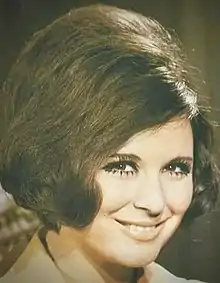 Soad Hosny in 1970 | |
| Born | Soad Hosny Elbaba 26 January 1943 |
| Died | 21 June 2001 (aged 58) Westminster, London, England |
| Other names | Cinderella of Egyptian cinema |
| Occupations |
|
| Years active | 1959–2001 |
| Notable work | Full list |
| Spouses | Salah Kurayyem
(m. 1968; div. 1969)Maher Awad (m. 1987) |
| Parent |
|
| Relatives | Nagat El-Sagheera (half-sister) |
Early life
Soad Muhammad Kamal Hosny was born in Bulaq district in Cairo, Egypt to Mohammad Hosni, a noted Egyptian[5] calligrapher and his second wife Gawhara Mohamed Hassan.[6][7][8] Her parents divorced and her mother married Abdul Monem Hafeez with whom she had six more children, thus giving Soad and her two sisters no fewer than 14 half-siblings.[9]
Her father's household was known as "the artists' home" because leading artists from across the Arab world regularly visited Hosni's home in Cairo for tuition and social interaction with the master calligrapher. Her father, whose artistic output included the production of frames for the silent movies and book covers, was well known across the artistic community. A number of his children became performance artists. Soad's half-sister, Nagat, was an actress and singer.[10] Her half-brother, Ezz Eddin Hosni (1927–2013), was a composer and taught Soad and Najat music and singing. Another sibling, Sami Hosni, became a cello player, jewellery designer, and calligrapher.[11] Yet another brother, Farooq, was a painter and his daughter Samira was also an actress.[12]
Career
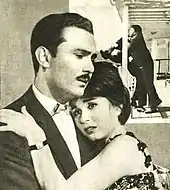
At the age of three, she began her career when she sang in the popular Egyptian children's TV program, Papa Sharo, hosted by prominent kids' shows presenter Mohamed Shaaban. Her work included a wide range of genres, from light comedies and romances through to political satire.[13]
Her film debut was in Hassan and Nayima (1959).[14] She is credited with acting in films with the most notable Egyptian film stars such as Omar Sharif, Salah Zulfikar, Rushdy Abaza, and Shoukry Sarhan. Her most well-known role was that of a college student who fell in love with her professor in Hassan El Imam’s film Watch Out for ZouZou (1972).[15] Other important film credits include her role in Hassan Al-Imam's Money and Women (1960) opposite Salah Zulfikar, whom she was paired with for the second time in Appointment at the Tower (1962) directed by Ezz El-Dine Zulficar. In 1964, she starred alongside Nadia Lutfi in Mahmoud Zulfikar's For Men Only, where she played a role of a girl disguised in a man's appearance to have the opportunity to work in an oil exploration project; the film was a box office hit. Hosny starred in Too Young for Love (1966) opposite Rushdy Abaza.
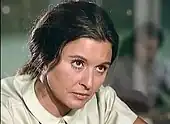
In 1970, she starred alongside Salah Zulfikar and Rushdy Abaza in the political film Sunset and Sunrise (1970) by Kamal El Sheikh. She worked in two films directed by Youssef Chahine during her career, the first one being The Choice (1970), and the second Those People of the Nile (1972) in which she was paired with Salah Zulfikar for the fourth time. In 1974, she starred in Kamal El Sheikh's Whom Should We Shoot? (1974) alongside Mahmoud Yassin. Her next role was a student and political activist who was tortured in Karnak (1975), the film was based on the novel by Naguib Mahfouz. In the films Shafika and Metwali (1979) with Ahmed Zaki and People on the Top (1981) with Nour El-Sherif, she transformed the musical numbers into scathing satires which gave voice to the oppressed. For this and her other hard-hitting, politically relevant roles, she was seen as part of the intelligentsia.[13]
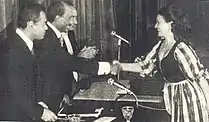
During her lifetime, she was known as the "Cinderella of the Screen". She starred in the films of every important Egyptian director during the 60s and 70s and played women in complex plots. In her later career, she played women who had been abused or victimized.[16] Due to illness and health issues, she retired from acting in 1991.[17] Hosny's final screen appearance was in The Shepherd and the Women (1991).[4]
Personal life
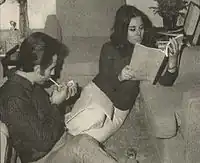
Soad Hosny was married four times.[18] Around 1968, she was married to cinematographer Salah Kurayyem; the marriage lasted for approximately one year. In 1970, Hosny was married to the Egyptian film director Ali Badrakhan; this marriage lasted for approximately eleven years. She was then married to Zaki Fatin Abdel Wahab, son of Fateen Abdel Wahab and Leila Mourad in 1981. This marriage lasted only five months. Persistent rumors claim that her first marriage was to the actor and singer, Abdel Halim Hafez (1929-1977), popularly known as "Al Andaleeb al Asmar" [The Dark-skinned Nightingale], whom she is believed to have married in secret.[19] However, her family have denied the veracity of such rumors.[20]
She was romantically linked with various celebrities including the Egyptian film star Abdel Halim Hafez.[21] Despite never wearing a wedding dress in all her marriages, Hosni wore wedding dresses many times on screen through her films, and her first film husband was the Egyptian film star Salah Zulfikar in Money and Women of 1960. The rumor of her marriage to Abdel Halim Hafez was not the first in her life. In late 1962, a rumor spread wass in the Egyptian press about her marriage to Salah Zulfikar, who’s one of his country's most iconic male performers of all time and was popularly known as "Fares al Ahlem" [Knight of the Dreams], while filming with Zulfikar in Appointment at the Tower. Filming of the film scenes began in the Cairo Tower, and the team continued for two weeks on board the ship Aida in the Mediterranean. After filming ended, the rumor of her marriage to Zulfikar spread in newspapers and magazines at the time. Zulfikar did not forget the nature of his previous work as a police officer and began with his sense of security to investigate the source of the rumor, to make sure that the lighting worker in the film crew was the owner of the rumor after a kiss was filmed between Zulfikar and Soad Hosny, where the kiss lasted for three minutes, until Zulfikar sensed it took them too long and told the cinematographer, "Stop", and so the worker built this rumor because of the shot, but this rumor was denied and later, the two film stars participated in more than one film together.[22] Her fourth and final marriage was to screen writer Maher Awad.[23]
Death

On 21 June 2001, Soad Hosny died after falling from the balcony of her friend Nadia Yousri's apartment in Stuart Tower building in Westminster. Her death was surrounded by controversy, with authorities initially failing to provide details of how she fell; an omission that fueled media speculation and rumors that her death may have been a suicide or murder rather than accidental.[24] Soad's body was flown home to Cairo[18] and her funeral there was attended by over 10,000 people. She was buried in a family's plot of land on the outskirts of Cairo.[25] She had no children and was survived by her last husband, writer Maher Awad, whom she married in 1987.[26][27]
Legacy

In 2013, Lebanese filmmaker Rania Stephan used snippets from Hosny's films to re-tell Hosny's story and the history of Egyptian cinema in The Three Disappearances of Soad Hosni.[28] It was featured in Berlin's Art Week.[29] The Three Disappearances is an important archive, which while following the chronology of Soad Hosny's career, simultaneously documents the costumes, sets and styles used from the 1950s to the 1990s, a period that marked the peak and decline of Egyptian cinema.[30]
One of Hosny's songs, "I'm going down to the Square" became a popular "anthem" during the 2011 Egyptian revolution.[30]
On 26 January 2022, Google Doodle celebrated Soad Hosny’s 79th birthday.[31][32]
Filmography
Soad Hosny's film career lasted for 32 years. She is an icon in Egyptian film industry. She was a film, stage, television, and radio actor. She appeared in more than 80 films, 1 play, 1 television miniseries, and several radio shows.[14]
References
- "وثيقة مكتوبة : شهادة ميلاد سعاد حسني 1943 م". souad.banouta.net. Retrieved 31 October 2016.
- "Roa'ya Assar – بالمستندات الرسمية: سعاد حسنى مصريه و اتولدت... | Facebook". www.facebook.com. Retrieved 29 October 2016.
- "Egyptian Cinderella". Retrieved 31 October 2015.
- "Egyptian screen star dies". bbc.co.uk. BBC News. 22 June 2001. Retrieved 24 February 2012.
- 11 Facts About Mohammad Hosni, retrieved 16 July 2023,
Mohammad Hosni was fond of calligraphy from his early childhood, and he migrated to Egypt at the age of 19, where he became a national
- Ahmad Al Samehi. Profile, Al-Ahram, 6 December 2012, Issue No. 46021: "Brother of Najat Al Saghira and Soad Hosny: I taught singing to Najat". Retrieved 4 July 2015. (in Arabic)
- "Mohammad Hosni the Calligrapher", City Talks, 24 June 2015, Retrieved 10 July 2015 While Soad’s birth certificate states that both parents were See: ”Soad’s Birth Certificate”, ELFAGR.org, 26 January 2017 <Online: https://www.elfagr.org/2442336>, other evidence indicates that her father only became a naturalised Egyptian in the 1960s
- al-Gamal, Hani (15 January 2021). "Loyal to his roots, director Badrakhan hopes to utilize cinema for the Kurdish cause". MedyaNews. Retrieved 29 October 2022.
- Mayad Beloun. Profile, Alsharq Al Awsat (newspaper), (3 August 2001), No. 8284.
- Najat Al Saghira profile, najatalsaghira.wordpress.com. Retrieved 4 July 2015.
- , Al-Etihad [newspaper], UAE, "Obituary of Ezz- Eldin Hosni"
- Mohammad Qenawi, "Najat Al Saghira wins 'Al Owais' Prize", 4 December 2006, Issue No. 10233. Retrieved 26 January 2016.
- Ginsberg, T. and Lippard, C., Historical Dictionary of Middle Eastern Cinema, Scarecrow Press, 2010, p. 181
- Lentz III, H.M., Obituaries in the Performing Arts, 2001: Film, television, Radio, Theatre, Dance, Music, Cartoons and Pop Culture McFarland, 2002, p. 146
- Ginsberg, T. and Lippard, C., Historical Dictionary of Middle Eastern Cinema, Scarecrow Press, 2010, pp 181–182; It may be worth noting that this source repeats stories occasionally published in the Arabic media, that her father was cruel and denied her an education until age 16 years. Her brother, in a media interview, dismissed this and other rumors about his family life, promulgated by the Arabic media, stressing that he and his siblings were raised in a supportive and artistic household where their talents were nurtured. See: Al-Samahi, A., "Najat's small brother and Suad Hosni: I learned to survive singing", (Interview with composer, Ezzidin Hosny), Al-Ahram, (Arabic newspaper in Egypt), 6 December 2012, Issue No. 46021, Online: (translated from Arabic)
- Marks, L..U., Hanan Al-Cinema: Affections for the Moving Image, MIT Press, 2015, p. 185
- "Egyptians Mourn Screen Cinderella", BBC News, Online:
- "Egyptians mourn screen Cinderella". BBC News. 28 June 2001. Retrieved 24 February 2012.
- Nassem Al-Kurd, “Soad Hosni: An Egyptian Cinderella of Kurdish Roots”, n.d.
- [http://www.abridgetoegypt.com/entertainment/egyptian_artists/abdelhalim_hafez “Abdel Halim Hafez’, A Bridge to Egypt, 17 August, 2011
- Allam, M., Vincere la Paura, Edizioni Mondadori, 2010, n.p
- "«بعد قبلة لمدة 3 دقائق».. كواليس شائعة زواج سعاد حسني وصلاح ذو الفقار". جريدة الدستور (in Arabic). 28 December 2020. Retrieved 26 January 2022.
- Nassem Al-Kurd, “Soad Hosni: An Egyptian Cinderella of Kurdish Roots”, n.d.
- Ginsberg, T and Lippard, C., Historical Dictionary of Middle Eastern Cinema Scarecrow Press, 2010, p. 182
- Soad Hosni funeral coverage, albayan.Ae, 29 June 2001.
- Al Arabiya (Arabic TV channel, Dubai); "Husbands of screen Cinderella ...". Retrieved 23 June 2011. Retrieved 10 July 2015.
- "Egyptians mourn screen Cinderella". 28 June 2001. Retrieved 20 November 2017.
- Harbord, J., Ex-centric Cinema: Giorgio Agamben and Film Archaeology, Bloomsbury Publishing USA, 2016, p. 101
- Rowan El Shimi, "Cinderella story of Egyptian cinema told through film on Soad Hosny", ahram.org.eg, 25 September 2013.
- Russell, C., Archiveology: Walter Benjamin and Archival Film Practices, Duke University Press, 2018 [E-book edition], n.p.
- "Soad Hosny's 79th Birthday". www.google.com. Retrieved 25 January 2023.
- Desk, OV Digital (25 January 2023). "26 January: Remembering Soad Hosny on Birthday". Observer Voice. Retrieved 25 January 2023.
Sources
- Terri Ginsberg, Chris Lippard, 2010: Historical Dictionary of Middle Eastern Cinema, Scarecrow Press.
- Ashraf Gharib, 2001: Soad Hosni: Al-Hulm Al-Dai (Soad Hosni: The Lost Dream). (Cf. "Return of Soad". Al-Ahram Weekly. 11–17 November 2001. Archived from the original on 18 October 2012. Retrieved 27 February 2012.)
- Mohamed Soweid, 2004: Cabaret Suad, Beirut: Dar al-Adab. (Cf. "The cornflake predicament". Al-Ahram Weekly. 16–22 June 2005. Archived from the original on 14 March 2012. Retrieved 27 February 2012.)
External links
- Soad Hosny at IMDb
- "...Zouzou"
- Profile (citing 1943 year of birth), ElCinema.com; (in Arabic) accessed 26 January 2015.
- Soad Hosny's 79th Birthday at Google Doodle
Articles and essays
- "رسالة السندريلا إلى الله!" (in Arabic; gives 1943 as year of birth)
- "Souad Hosny dies in London after struggling with disease", aawsat.com (in Arabic; gives 1944 as year of birth)